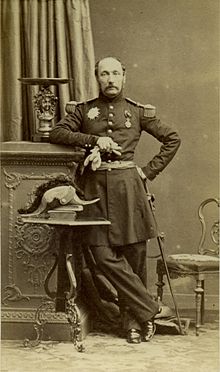Viscount Armand-Octave-Marie d'Allonville (21 January 1809 – 19 October 1867) was a French general of division which distinguished himself during the French conquest of Algeria and the Crimean War. He was later appointed senator.
Armand d'Allonville | |
|---|---|
 General Armand d'Allonville | |
| Born | 21 January 1809 Hanover, Kingdom of Westphalia |
| Died | 19 October 1867 (aged 58) Versailles, French Empire |
| Buried | |
| Allegiance | |
| Service | French Army |
| Years of service | 1830–1865 |
| Rank | General of Division |
| Unit | Spahis Chasseurs d'Afrique |
| Battles / wars | Belgian Revolution |
| Awards | |
| Other work | Senator |
Biography
editOrigins
editArmand d'Allonville was born 21 January 1809 in Hanover, then under French occupation, from viscount Antoine Jean Baptiste d'Allonville (1765–1811) and Céleste Octavie de La Bourdonnaye (1787–1863).[1] His family has a military heritage that dates back from the Crusades.[1] A noble from Brittany, his father had emigrated during the French Revolution and d'Allonville was re-naturalized French in Rennes in 1830.
Early military career
editAfter his graduation from the École d'application du Corps royal d'état-major, he entered the cavalry. He witnessed the Siege of Antwerp in 1832, as aide-de-camp of General Rulhières.
During the conquest of Algeria, he commanded an indigenous irregular cavalry squadron. After the battle of the Smala, he received the officer cross of the Légion d'honneur. At the Battle of Isly, he distinguished himself by taking the Moroccans' cannons with his Spahis.
In 1839, he was appointed lieutenant-colonel of the 1st Regiment of Spahis by Marshall de Saint Arnaud.
Napoleon III's coup
editColonel of the 5th Hussar Regiment in 1845, he was promoted general of brigade in 1851 and participated to Napoléon III's coup d'état, 2 December 1851. He commanded a division of cavalry on the Champs-Élysées, but did not meet hostility from the Parisian crowd.
Crimean War
editD'Allonville was the commandant of the Chasseurs d'Afrique brigade during the Charge of the Light Brigade. Under his command, the Chasseurs d'Afrique cleared the two half batteries of guns, two infantry battalions and Cossacks on the Fedyukhin Heights to ensure the British Light Brigade would not be hit by fire from that flank and later provided cover for the remaining elements of the Light Brigade as they withdrew.[2][3]
For this brilliant feat of arms, d'Allonville was promoted general of division and commanded, from 20 May 1855, the 1st brigade, comprising the 1st and 4th hussar regiments, and the 2nd brigade, comprising the 6th and 7th dragoon regiments.
At the battle of Eupatoria, d'Allonville led the 4th hussar and the 6th and 7th dragoon regiments and was made Grand-Croix of the Légion d'honneur and received the Order of the Bath from the British and the Order of the Medjidie from the Turks.[1]
Later life
editD'Allonville's declining health led him to leave active service in the French army and he became conseiller-général of Ille-et-Vilaine. He was appointed senator in December 1865 and died 19 October 1867 in Versailles. He was interred in Père Lachaise Cemetery in Paris.[1]
References
edit- ^ a b c d Larousse.fr
- ^ Correspondent (14 November 1854). "The Cavalry Action at Balaclava 25 October". The Times (21898): pp 7–8. Although unnamed, the correspondent was William Howard Russell.
- ^ History of war
Bibliography
edit- D'allonville's genealogy (FR)
- Le livre d'or de l'Algérie, Narcisse Faucon, Challamel et Cie Éditeurs Librairie Algérienne et Coloniale, 1889 (FR)
- British Military Intelligence in the Crimean War, 1854–1856, par Stephen M. Harris.
- La contestation chez les cadres de l'Armée franc̜aisede 1650 à 1986, par Pierre Denis (FR)